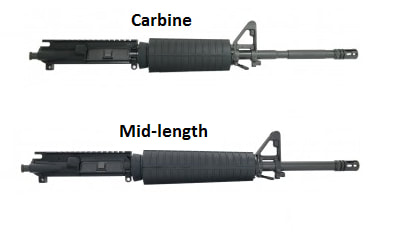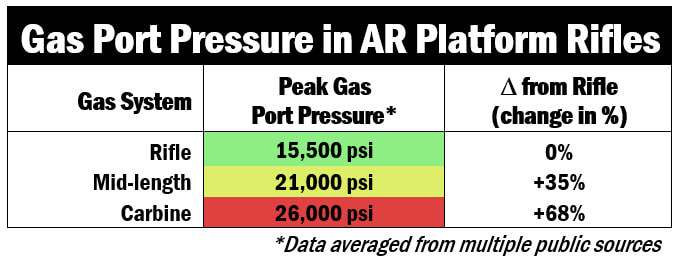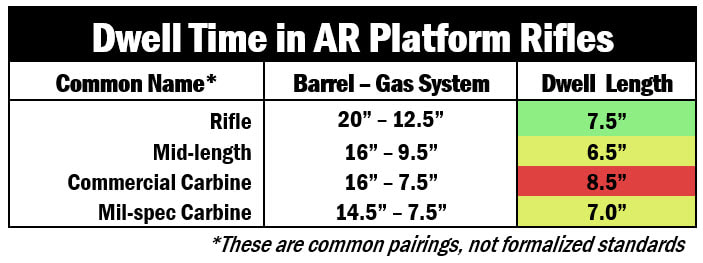Please help me understand what the differences when it comes to looking at AR 15 uppers. I do not know what the functional differences between these types of configurations and what their pros and cons are. What do I gain what do I lose what am I missing?
Unconfigured Ad Widget
Collapse
|
|
|
|
|
|
|
|
Rifle length, carbine length, pistol length, WTF, over?
Collapse
X
-
I don't get it either, but I found that having a rifle/full length buffer for any of those gas types makes the shooting flatter and more reliable.
Or the ARs I bought was something wrong. I just switched all to rifle length buffer, and seemed better.Last edited by CheapBloke; 04-08-2021, 4:34 PM. -
It has to do with how much gas is sent into the gas port vs. out the barrel, as the bullet passes the gas port but continues to block the end of the barrel before it exists. This can have an impact on reliability depending on the length of barrel you are going to use. Basically, you match the gas system length to the barrel length, more-or-less.
Here's a PDF from the Naval Warfare Center's study into Mid Length vs Carbine Length gas systems. (they concluded Mid-length was more reliable, from a malfunction perspective - Note, they used 14.5" barrels to test)
And a blog post from AT3 about each.
On a 16" barrel, Mid-length offers all-around good performance.
Others will know more specifics, but those articles/pdf should get you started Last edited by NorCalRefuge; 04-08-2021, 4:47 PM.
Last edited by NorCalRefuge; 04-08-2021, 4:47 PM.Comment
-
I think OP is asking about gas lengths, not buffers.
You may have benefited from running an H1 or H2 carbine buffer, instead of going to the super long rifle buffer. Or, some would say your rifle is over-gassed and that should be fixed instead.
An H3 carbine buffer and a Rifle buffer seem to both weigh about the same, ~5 oz.
The rifle buffer limits the stock options you have available to you - but if you're running featureless with a true-fixed stock (instead of a pinned/blocked adjustable) then I suppose it doesn't matter.Comment
-
In an overly simplistic sense...
Rifle length = 20"-plus barrel
Mid-length = 16" barrel
Carbine-length = 14.5" barrel

The gas tube length is adjusted accordingly; i.e., the pressures increase as the barrel shortens.

As such, the weight of the buffer is then adjusted to compensate so that the timing for the bolt is appropriate.

The above images come from... Mid-length vs. Carbine Gas Systems in AR-pattern Rifles ... which has a more complete discussion.
Over the years, there has been some criticism related to reliability/function issues with carbines. While the vast majority have been related to full auto, it has filtered into the thinking on the semi-autos. Is there a problem for semi-autos? Eh. Maybe, possibly, not really, sort of, for some...
Here's a discussion comparing the gas tubes...
Again, in an overly simplistic sense, the gist tends to be interpreted as... Rifle length = most reliable, Mid-length = best compromise, Carbine-length = least reliable. The problem is such an interpretation largely ignores the inherent adaptability of the system and, instead, focuses on "stock" purchases of complete firearms. It's why there are so many threads on which gas block, which buffer, etc.In addition to the impact the right gas tube has on the gun's function, gas systems are compatible with different-sized handguards. If your gas system is too long, it may not even fit on the rifle. The good news is that choosing the right sized gas system is simple:
- Pistol-length gas systems: The pistol length gas system is the shortest of the gas systems and is on average only 4.5 inches
- Carbine-length gas systems: A carbine length gas system is the most common and has a gas tube about 7.5 inches long. AR-15s with shorter 10-18-inch barrels function their best when paired with a carbine-length gas system.
- Mid-length gas systems: Mid-length systems are a little bit longer and measure in at approximately 9.5 inches. Carbines with barrels 14 to 20 inches long will deliver optimal results with mid-length gas systems.
- Rifle-length gas system: The longest of the three, rifle-length gas systems use gas tubes close to 13 inches long. You should install rifle-length gas systems on marksman-style AR-15s with barrels 20 inches or longer...
There's more to getting the most from an AR-15 gas system than length. To get the best results when you pull the trigger, make sure you also consider your:
- Buffer weight: Your buffer weight can affect the performance of your gas system. While heavier buffers are great for absorbing recoil, you need to make sure your gas system is strong enough to power it. If you go too light, you'll wind up taking more impact when you fire and putting extra wear on your rifle. Find one that provides a balance.
- Gas block: If you still have the stock gas block that came with your rifle, you're missing out on performance. Aftermarket gas blocks are easy to install, and an adjustable gas block offers several advantages. With an adjustable gas block, you can control the exact amount of pressure channeled back through your system.
- Ammunition type: Even if you're loyal to a brand, there are still many types of ammo out there you can use with an AR-15. Heavier bullets take longer to leave the barrel, increasing dwell time and building extra gas pressure. If your bullets are too light, they can leave the barrel before you build enough pressure to cycle the next round.
The bottom line is that, particularly if 'building' your own, then you'll need to balance the system correctly for fit and function. If you want a rifle, then the rifle-length is just that. If you want a shorter barrel length, then you'll need to decide whether to go with a carbine or mid length barrel, which dictates the gas tube length, which impacts the weight of the buffer, etc.Comment
-
Sorry to steer this off of the original topic but which size buffer would you recommend for each size gas system?
Dictated but not read, voice typing plus bad eyes equals typosdictated but not read
Voice typing will butcher whatever I was trying to sayComment
-
There is no, single, one-size-fits-all answer to that question.
AR-15 BUFFER WEIGHT (AND WHY IT MATTERS)
In general, a rifle buffer for rifle length and a carbine buffer for mid-length and carbine length work. But... There are myriad factors which can influence the decision...
- What BCG are you using? (Ex.: The extra weight of a "full auto" version, coupled with a carbine buffer could be all that is needed for a mid-length. But, for a carbine-length, you might want to go to an heavier buffer if utilizing a lighter BCG.)
- What ammo are you shooting?
- What buffer spring do you have?
- What is your gas port size?
Here's a discussion... Choosing the Right Buffer for Your AR-15
In general, the standard rifle and standard carbine buffers will work. Will they work optimally based on your unique firearm becomes the question.Comment
-
Ah, thanks for that info.I think OP is asking about gas lengths, not buffers.
You may have benefited from running an H1 or H2 carbine buffer, instead of going to the super long rifle buffer. Or, some would say your rifle is over-gassed and that should be fixed instead.
An H3 carbine buffer and a Rifle buffer seem to both weigh about the same, ~5 oz.
The rifle buffer limits the stock options you have available to you - but if you're running featureless with a true-fixed stock (instead of a pinned/blocked adjustable) then I suppose it doesn't matter.Comment
-
what is the most accurate 9mm carbine semi-auto, preferably that will accept sig p226 magazines. i think i found one, but i assume i would have to get the 16" barrel or it would have to be registered as an assault weapon?
this is pretty expensive, but it allows me to use the magazines i have (since 1992).Comment
-
all "ARs" are gas operated.Originally posted by ThatPunkGirlWhat does it mean when an AR is gas operated?
an example of something that is not gas operated is your typical pistol or an M2 shotgun that uses the recoil to "operate" or cycle the action.Comment
-
Imagine a round going off in an AR, in extreme slow-mo. As the powder ignites, it turns from solid to gas & expands and with nowhere to go it's pushing the projectile forward. Referencing post 5 & the relative distances of the front sight post/gas port, in a carbine setup the projectile will reach the front sight post relatively quickly compared to a midlength setup which has the gas port further forward on the barrel. Once the projectile has passed the gas port, there's another path for the expanding gases to go, which is through the gas port, into the gas tube, and backwards towards the bolt carrier thus pushing it back (ie gas operated). In that interval where the projectile is forward of the gas port but hasn't left the barrel yet, that's called the dwell time (or dwell length). Gas is still expanding and it's pushing the projectile forward and also pushing the bolt carrier back. Once the projectile has exited the barrel then pressure very quickly drops back to zero.
In a carbine setup with the gas port being further back, not only will the bolt carrier be pushed back sooner but also with more force and for a longer period of time compared to other lengths. Imagine the hypothetical slow-mo projectile at just .0001" forward of the gas port. This is when pressure can bleed off onto the gas tube, and also the point when max gas port pressure occurs, and there is still pressure until the projectile exits the barrel. With only 7.5" of barrel until the gas port, there's less volume thus more pressure. With midlength systems there's 9.5" of barrel, and thus a little more volume & subsequently a little less max pressure. Intuitively we can see this by comparing carbine vs rifle length systems. Rifle length systems have the gas port at 12.5"- almost double that of the 7.5 carbine length - and we see that max port pressure is also almost half.
The length of the barrel forward of the gas port is also important, because it leads to how long gas is pushing back on the bolt. Remember that when the projectile is forward of the gas port, but hasn't left the barrel yet, there's still pressure on both the projectile and the bolt carrier. The longer the dwell length, the more that gas continues to push on the bolt carrier.
The end result is that carbine systems tend to have more of a felt recoil because not only does the bolt get pushed back sooner, but there's continuing pressure for a longer period of time. Rifle systems have the least felt recoil (actually dissipator systems have the least, but they're not common) because there's less max gas port pressure and less dwell time.
But that doesn't mean any one system is better or worse. A harder-pushing carbine system may kick a little more, but it will reliably cycle weaker ammo. Or if the system is unlubricated or gunked up, the gas system will still have enough energy to overcome the extra friction from lack of lubrication. A softer shooting rifle system may feel better, but it has a narrower range of ammo it can use. A midlength system is a compromise, but a compromise also implies it isn't good at anything.---------------------
"There is no "best." If there was, everyone here would own that one, and no other." - DSBComment
-
Shorter (carbine) equals more recoil but clears the shell like a champ while beating on the gun. I use this for home defense. Rifle is softer shooter because of the longer gas system and I use this for target/hunting because of less recoil.
Basically over gassed will keep the gun running. Under gassed will make it feel less recoil but at the disadvantage of reliability. This is a massive oversimplification but either can be tuned to work 100% once you start playing with it. Competition shooters run incredibly balanced soft shooters once you start tuning the gun.Last edited by deckhandmike; 04-08-2021, 7:56 PM.Comment
-
They all are, I think what you are referring to is gas piston vs direct impingement...gas piston is more like the way an AK works. Direct impingement is what ARs used originally...requires more maintenance so some people opt for gas piston.Originally posted by ThatPunkGirlWhat does it mean when an AR is gas operated?NRA Lifetime member
CRPA Lifetime member
Second Amendment Foundation Life memberComment
-
Great post, cleared up some areas I never truly understood, thxImagine a round going off in an AR, in extreme slow-mo. As the powder ignites, it turns from solid to gas & expands and with nowhere to go it's pushing the projectile forward. Referencing post 5 & the relative distances of the front sight post/gas port, in a carbine setup the projectile will reach the front sight post relatively quickly compared to a midlength setup which has the gas port further forward on the barrel. Once the projectile has passed the gas port, there's another path for the expanding gases to go, which is through the gas port, into the gas tube, and backwards towards the bolt carrier thus pushing it back (ie gas operated). In that interval where the projectile is forward of the gas port but hasn't left the barrel yet, that's called the dwell time (or dwell length). Gas is still expanding and it's pushing the projectile forward and also pushing the bolt carrier back. Once the projectile has exited the barrel then pressure very quickly drops back to zero.
In a carbine setup with the gas port being further back, not only will the bolt carrier be pushed back sooner but also with more force and for a longer period of time compared to other lengths. Imagine the hypothetical slow-mo projectile at just .0001" forward of the gas port. This is when pressure can bleed off onto the gas tube, and also the point when max gas port pressure occurs, and there is still pressure until the projectile exits the barrel. With only 7.5" of barrel until the gas port, there's less volume thus more pressure. With midlength systems there's 9.5" of barrel, and thus a little more volume & subsequently a little less max pressure. Intuitively we can see this by comparing carbine vs rifle length systems. Rifle length systems have the gas port at 12.5"- almost double that of the 7.5 carbine length - and we see that max port pressure is also almost half.
The length of the barrel forward of the gas port is also important, because it leads to how long gas is pushing back on the bolt. Remember that when the projectile is forward of the gas port, but hasn't left the barrel yet, there's still pressure on both the projectile and the bolt carrier. The longer the dwell length, the more that gas continues to push on the bolt carrier.
The end result is that carbine systems tend to have more of a felt recoil because not only does the bolt get pushed back sooner, but there's continuing pressure for a longer period of time. Rifle systems have the least felt recoil (actually dissipator systems have the least, but they're not common) because there's less max gas port pressure and less dwell time.
But that doesn't mean any one system is better or worse. A harder-pushing carbine system may kick a little more, but it will reliably cycle weaker ammo. Or if the system is unlubricated or gunked up, the gas system will still have enough energy to overcome the extra friction from lack of lubrication. A softer shooting rifle system may feel better, but it has a narrower range of ammo it can use. A midlength system is a compromise, but a compromise also implies it isn't good at anything.NRA Lifetime member
CRPA Lifetime member
Second Amendment Foundation Life memberComment
-
I am running a 10.3 inch upper on my Daniel Defense Mk18 SBR. It also has an OSS 556 Ti suppressor, H2 buffer and braided buffer spring by Geissele and it shoots with no blowback and felt recoil is as much as a 22L rifle but with the sound in the 130s db range. Low to no recoil what so ever. All are DI guns. I am not a fan of gas pistol guns. They were a fad 10+ years ago.
None of my AR barrels are over 12.5 inches.Last edited by Endless; 04-08-2021, 11:59 PM.Comment
Calguns.net Statistics
Collapse
Topics: 1,855,436
Posts: 25,007,192
Members: 353,847
Active Members: 5,785
Welcome to our newest member, RhythmInTheMeat.
What's Going On
Collapse
There are currently 4690 users online. 68 members and 4622 guests.
Most users ever online was 65,177 at 7:20 PM on 09-21-2024.


Comment